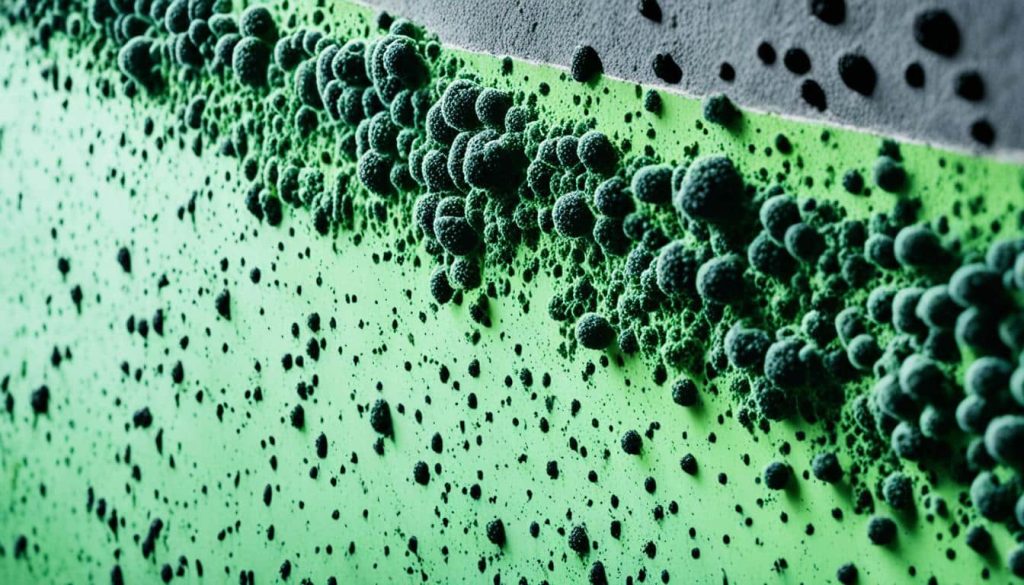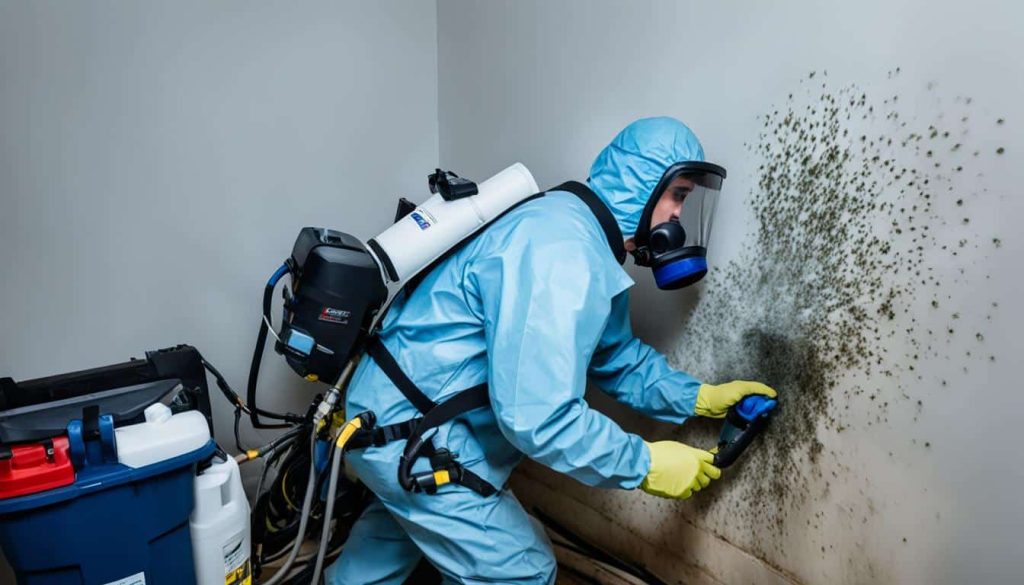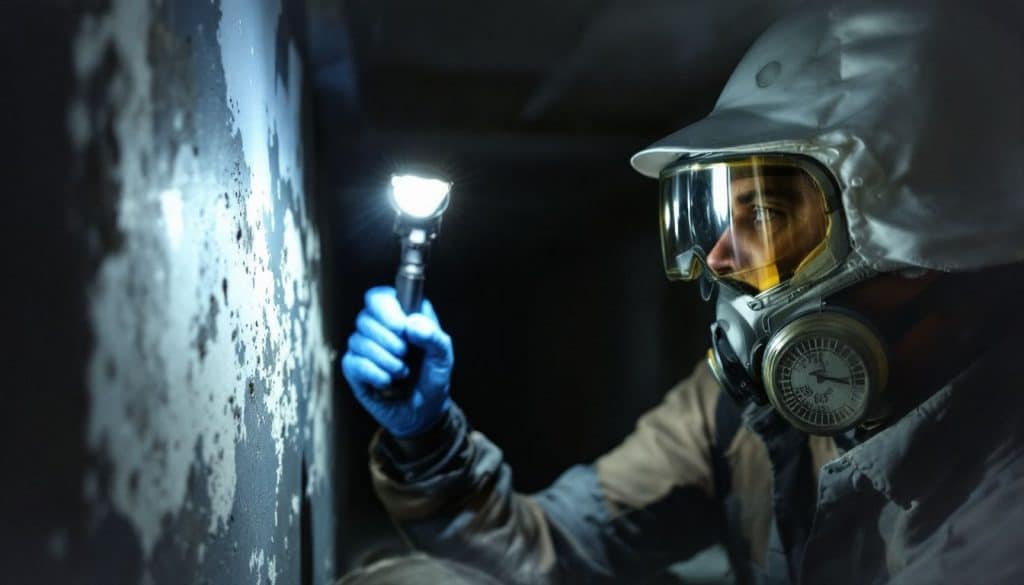Table of Contents
Ever wondered if Can Mold Remediation Prevent Mold from Coming Back? Mold is a big problem for many of us. It damages our homes and hurts our health. If you’re wondering if mold remediation can keep it away forever, you’re not alone.
Mold doesn’t wait and can grow in 24 to 48 hours if it’s right. So, we looked into how to stop it from coming back after removal. Getting answers was a must.
This piece will give you tips on managing moisture and the importance of regular mold inspections. We’ll also teach you how to get rid of mold for good. Plus, we’ll tell you when to call in the pros.
Stay tuned; there’s more than you think!
Key Takeaways
- Mold loves damp places, so controlling moisture is key to keep it away. Fix leaks and use dehumidifiers.
- Regular mold inspections find hidden problems early. This stops mold before it spreads.
- Professionals like Array of Solutions know how to remove mold safely. They also give tips to stop it from coming back.
- Keeping indoor air clean helps prevent mold. Open windows for fresh air and use fans.
- If you see signs of mold or can’t control moisture, call the experts for help.
Understanding and Preventing Mold Recurrence
Mold can easily grow in our homes and businesses. It thrives in damp areas, so we need to cut down moisture to keep it away.
Causes of Mold Growth
Mold grows in damp areas. It loves moisture, darkness, and warmth. Common causes of mold growth include leaks in roofs or pipes. High humidity levels also help mold thrive.
We often see mold after water damage. Floods can leave homes wet for a long time. Poor ventilation traps moisture inside buildings too. When these conditions exist, mold can quickly spread, making prevention key to keep our spaces safe and healthy.
Importance of Mold Prevention Techniques
Mold prevention techniques are key for all homeowners and business owners. We must keep our spaces safe and healthy. Mold can grow quickly in damp places. It thrives where there is moisture.
By controlling moisture, we reduce the chance of mold growth.
Using proper mold prevention methods helps avoid problems later on. Regular inspections help spot issues before they get worse. Effective mold removal techniques stop it from coming back.
This protects our indoor air quality too. Healthy spaces lead to happier lives and better work environments for everyone involved.
The Process of Mold Remediation
Mold remediation starts with a thorough inspection of the affected areas. We use different techniques to safely remove mold and prevent it from returning.
Steps of Mold Inspection
Mold inspection is a key step in mold remediation. It helps us find hidden issues and prevents mold from returning.
- Visual Inspection: We start by looking for signs of mold growth. This includes checking walls, ceilings, and floors. We pay special attention to damp areas like basements and bathrooms.
- Moisture Assessment: Next, we measure moisture levels in the air and materials. High moisture can lead to mold growth. We use tools like moisture meters to get accurate readings.
- Air Quality Testing: Testing the air helps us find mold spores that are not visible. We collect samples from different areas of the property. This data helps us understand the extent of the problem.
- Surface Sampling: In some cases, we may take samples from surfaces showing signs of mold. These samples help identify the type of mold present. Knowing this is important for proper mold eradication.
- Identifying Moisture Sources: We look for leaks or water damage that caused the mold growth. Fixing these sources is essential to prevent future issues.
- Creating a Mold Remediation Plan: After inspection, we develop a plan for treatment based on our findings. The plan outlines steps for safe removal and control measures.
- Documentation: Lastly, we document all findings and steps taken during inspection. This record is valuable for future reference and helps in ongoing mold management strategies.
Following these steps ensures effective mold abatement and reduces chances of reoccurrence in our homes or businesses.
Mold Removal Techniques
Mold removal is key to stop mold from coming back. We use different techniques to remove it effectively.
- Identify the Source: We must first find where the moisture comes from. Fixing leaks or drainage issues helps prevent mold growth.
- Physical Removal: We begin by taking away any visible mold. This step includes scrubbing surfaces with a mixture of water and soap or a special cleaner for mold treatment.
- Use of Antimicrobial Products: After cleaning, we often apply antimicrobial solutions. These products help kill any remaining mold spores and stop new ones from forming.
- Remove Affected Materials: Sometimes, we must discard parts of materials that are too damaged, like drywall or carpeting. This ensures that all mold is gone and cannot grow back.
- Drying the Area: It is vital to dry out the area completely after cleaning. Using fans or dehumidifiers can help speed up this process and reduce moisture levels in the air.
- Seal Surfaces: To prevent future mold infestation, we might seal surfaces with paint or coatings designed for mold control. This added layer can keep moisture out and limit mold growth.
- Maintain Good Ventilation: We should ensure proper air flow in our homes or businesses. Open windows and use exhaust fans to keep indoor air fresh and dry.
- Regular Inspections: Conducting regular checks helps us catch any signs of mold early on. Early detection means easier removal before it spreads.
Using these techniques forms an important part of the overall mold remediation process, aiding in long-term prevention against mold recurrence in our spaces.

Mold Abatement Process
The mold abatement process helps us remove mold safely and effectively. This process also works to prevent mold from coming back.
- Initial Assessment
We start by carefully checking the area. This helps us find where the mold is and how much there is. - Containment Setup
Then, we set up barriers to stop mold spores from spreading. This step is very important to protect other parts of the home or building. - Air Filtration
We use air scrubbers with HEPA filters during our work. These devices catch tiny mold particles and improve the air quality as we work. - Removal of Mold-Infested Materials
Items that can’t be cleaned, like drywall or carpets, are removed safely. We put these materials in sealed bags to prevent spores from spreading. - Cleaning Surfaces
All affected surfaces are cleaned using special solutions. This keeps any remaining mold from growing back later. - Drying Out Affected Areas
To stop future growth, we thoroughly dry out all areas that had moisture. Fans and dehumidifiers often help in this stage. - Final Inspection
A thorough check ensures all mold has been removed properly. This step helps confirm that the area is safe again. - Preventive Measures
After we finish, we suggest ways to control moisture better in the future. These tips can help with long-term prevention of mold growth.
This process is key in helping homeowners and business owners deal with mold recurrence prevention effectively. Mold remediation can support us all in creating a healthier environment for everyone involved.
Tips to Prevent Mold from Coming Back
Mold likes damp places. We must keep our homes dry to stop it from coming back.
Moisture Control
Moisture control is key to stopping mold from coming back. We need to keep our spaces dry. Mold thrives in damp areas. Check for leaks and fix them right away. Use dehumidifiers where needed.
Keeping humidity below 60% can help prevent mold growth.
We must also ventilate our homes and businesses well. Open windows to let in fresh air when the weather allows. Regularly inspect basements, bathrooms, and kitchens for signs of moisture too.
Taking these steps will aid in better moisture prevention, keeping us safe from mold reoccurrence in the future.
Regular Mold Inspections
Regular mold inspections are key to preventing mold growth. Array of Solutions check our homes and businesses for hidden damp areas. These spots can lead to fungal issues if not spotted early.
By inspecting regularly, we catch problems before they escalate.
Professionals like Array of Solutions knows how to identify mold signs. They look in basements, attics, and behind walls where moisture can hide. This step is essential for effective mold mitigation.
Staying informed helps us maintain good indoor air quality and keeps our spaces safe from future mold threats.
Proper Mold Remediation Process
The proper mold remediation process is key to stopping mold growth. First, we inspect the area for moisture and visible mold. Next, we remove all affected materials. This includes drywall, carpet, or anything that holds moisture.
After removal, we clean surfaces with special solutions to kill remaining spores.
We then fix any leaks or sources of water to prevent future growth. Keeping areas dry is a big part of the process. Proper ventilation can also help reduce humidity levels in our spaces.
By following these steps carefully, we can effectively prevent mold from coming back after remediation.
Maintaining Indoor Air Quality
We need to keep our indoor air clean. Good air quality helps prevent mold growth. High humidity can lead to mold. We should use dehumidifiers in damp areas. This keeps moisture levels low.
Ventilation is also key for fresh air. Opening windows and using fans can help move stale air out. Regularly changing air filters in HVAC systems keeps pollutants away too. By maintaining indoor air quality, we fight against mold growth and create a healthier space for everyone.
When to Call Professionals
If we notice mold coming back, it’s time to call the experts. Array of Solutions has the tools and knowledge to tackle tough mold issues safely.
Signs of Mold Recurrence
We need to watch for signs of mold recurrence. Look for dark spots on walls, ceilings, or floors. Musty odors and increased allergy symptoms can also signal mold’s return.
If we see these signs, we should act quickly.
Preventing mold growth starts with noticing changes. Water stains can indicate leaks or damp areas. Regularly check places like bathrooms and basements. This helps catch problems early.
Importance of Professional Mold Remediation
Professional mold remediation is essential for our safety. Mold can cause health problems, like allergies or breathing issues. It often grows in hidden spots, so we might not see it until it’s too late.
Array of Solutions has the right tools to find and remove all mold effectively.
Proper mold removal stops future growth. Experts know how to eliminate moisture, a big reason for mold return. They also improve indoor air quality, making our homes and businesses healthier.
Investing in professional services reduces the risk of mold coming back. It’s smart and keeps our spaces safe from harmful fungi.
Mold Prevention Services
Mold prevention services keep our homes and businesses safe. We need these services to stop mold from growing again. Professionals can check for leaks and other moisture problems.
They use special tools to find hidden mold sources.
We should also consider regular inspections. This way, we can catch any signs of mold early. Mold remediation helps remove existing problems, but it does not end there. By using proper mold prevention techniques, we can ensure long-term prevention.
Conclusion
We’ve learned that mold remediation can help stop mold from coming back. We must tackle moisture and keep our spaces dry. Regular checks for mold are key to prevention. Using good removal techniques also plays a big part in keeping homes safe.
Proper indoor air helps too, ensuring cleaner environments for everyone.
Our efforts can lead to healthier spaces and happier lives. For more tips or help, we can reach out to Array of Solutions. Taking action now will pay off in the long run! Let’s keep our homes mold-free and enjoy peace of mind together.

FAQs
What is mold remediation?
Mold remediation is a process that helps to remove and clean up mold from an indoor area.
Can Mold Remediation Prevent Mold from Coming Back?
Yes, proper fungal remediation can help in preventing the return of mold by addressing the root cause of its growth.
How does fungal remediation work for prevention?
Fungal Remediation works by not only removing existing molds but also taking steps like controlling moisture levels to prevent future growth.
Is it guaranteed that after a successful mold removal, it won’t grow back?
While effective Mold Remediation reduces the chance of regrowth significantly, maintaining low moisture levels and regular checks are necessary for complete prevention.

